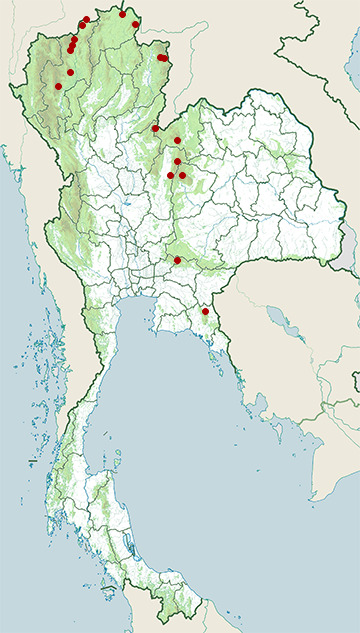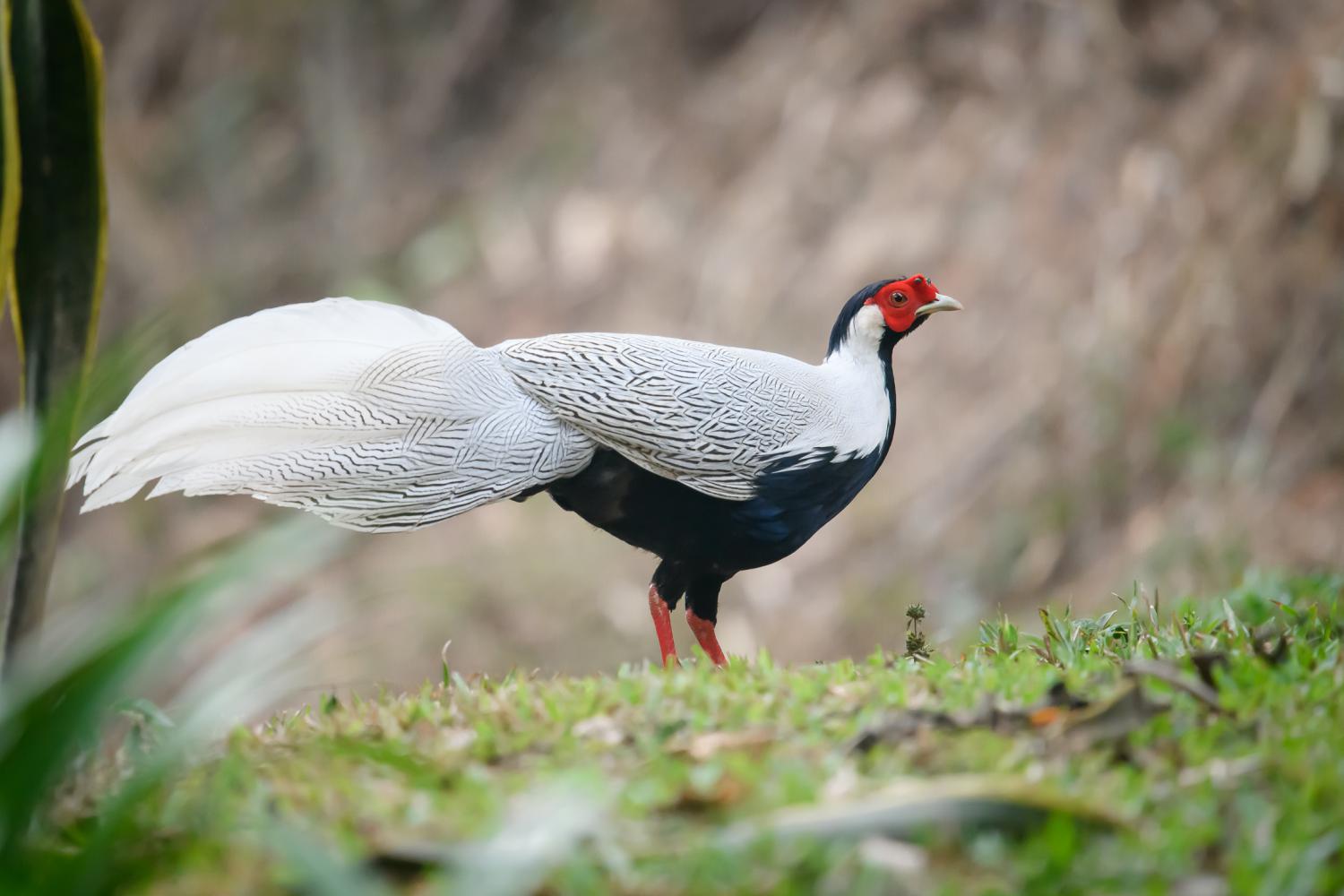Species of Thailand
Silver pheasant
Lophura nycthemera
Carolus Linnaeus, 1758
In Thai: ไก่ฟ้าหลังขาว
The silver pheasant (Lophura nycthemera) is a species of pheasant found in forests, mainly in mountains, of mainland Southeast Asia, and eastern and southern China, with introduced populations in Hawaii and various locations in the US mainland. The male is black and white, while the female is mainly brown. Both sexes have a bare red face and red legs (the latter separating it from the greyish-legged kalij pheasant). It is common in aviculture, and overall also remains common in the wild, but some of its subspecies (notably L. n. whiteheadi from Hainan, L. n. engelbachi from southern Laos, and L. n. annamensis from southern Vietnam) are rare and threatened.
Taxonomy
Like other pheasants, the silver pheasant was placed in the genus Phasianus when described by Carl Linnaeus in his landmark 1758 10th edition of Systema Naturae. Since then, it – or at least some of the subspecies associated with it – have been placed either in Euplocamus or Gennceus. Today all major authorities place the silver pheasant in Lophura.
The silver pheasant is closely related to the kalij pheasant and the two are known to hybridize. The placement of the taxa L. n. lineata and L. n. crawfurdi has been a matter of dispute, with some treating them as subspecies of the kalij pheasant and others as subspecies of the silver pheasant. They have greyish legs as in the kalij pheasant, but their plumage is closer to that of some subspecies of the silver pheasant. Additionally, as the silver pheasant, L. n. lineata and L. n. crawfurdi are found east of the Irrawaddy River, a major zoogeographic barrier, while all other subspecies of the kalij pheasant are found west of the river (L. n. oatesi, a subspecies of the kalij pheasant, has sometimes been reported as occurring east of that river, but this is incorrect). Based on mtDNA, it was recently confirmed that L. n. lineata and L. n. crawfurdi should be regarded as subspecies of the kalij pheasant.
With these two as subspecies of the kalij pheasant, the silver pheasant has 15 subspecies. However, while some subspecies are relatively distinctive, several others (at least L. n. rufipes, L. n. occidentalis, L. n. ripponi, L. n. jonesi, L. n. beaulieui, L. n. nycthemera, and L. n. fokiensis) are likely part of a cline, which if confirmed, would result in them being junior synonyms of the nominate subspecies. Several other taxa, for example L. n. andersoni, are now considered invalid by all major authorities.
Once considered a very rare species, the imperial pheasant is actually a naturally occurring hybrid between the silver pheasant and the Vietnamese pheasant.
Subspecies
The 15 recognized subspecies of the silver pheasant are, in taxonomic order:
- L. n. occidentalis – western silver pheasant – south central China and northeastern Myanmar
- L. n. rufipes – ruby mines silver pheasant – northern Shan State of northern Myanmar
- L. n. ripponi – Rippon's silver pheasant – southern Shan State of northern Myanmar
- L. n. jonesi – Jones's pheasant – Myanmar to southwestern China and central Thailand
- L. n. omeiensis – Szechwan silver pheasant – southern Sichuan in south central China
- L. n. rongjiangensi – Kweichow silver pheasant – southeastern Guizhou in south central China
- L. n. beaulieui – Lao silver pheasant – south central China to northern Laos and northern Vietnam
- L. n. nycthemera – nominate – southern China to northern Vietnam
- L. n. whiteheadi – Hainan silver pheasant – Hainan in southern China
- L. n. fokiensis – Fokien silver pheasant – southeastern China
- L. n. berliozi – Berlioz's silver pheasant – western slopes of Annamite Range in central Vietnam
- L. n. beli – Bel's silver pheasant – eastern slopes of Annamite Range in central Vietnam
- L. n. engelbachi – Boloven silver pheasant – Bolaven Plateau of southern Laos
- L. n. lewisi – Lewis's silver pheasant – mountains of southwest Cambodia and east Thailand
- L. n. annamensis – Annam silver pheasant – montane forests of southern Vietnam
Description
This is a relatively large pheasant, with males of the largest subspecies having a total length of 120 to 125 cm, including a tail up to 75 cm, while the males of the smallest subspecies barely reach 70 cm in total length, including a tail around 30 cm. The body mass of males can range from 1.13 - 2.00 kg. Females of all subspecies are notably smaller than their respective males, with a size range of 55 - 90 cm in total length, including a tail of 24 - 32 cm. The body mass of females can range from 1.0 - 1.3 kg.
Males of the northern subspecies, which are the largest, have white upperparts and tail (most feathers with some black markings), while their underparts and crest are glossy bluish-black. The males of the southern subspecies have greyer upperparts and tail with extensive black markings, making them appear far darker than the northern subspecies. The adult male plumage is reached in the second year.
Females are brown and shorter-tailed than the males. Females of some subspecies have whitish underparts strongly patterned with black, and in L. n. whiteheadi this extends to the upper mantle.
This article uses material from Wikipedia released under the Creative Commons Attribution-Share-Alike Licence 3.0. Eventual photos shown in this page may or may not be from Wikipedia, please see the license details for photos in photo by-lines.
Category / Seasonal Status
BCST Category: Recorded in an apparently wild state within the last 50 years
BCST Seasonal status: Resident or presumed resident
Scientific classification
- Kingdom
- Animalia
- Phylum
- Chordata
- Class
- Aves
- Order
- Galliformes
- Family
- Phasianidae
- Genus
- Lophura
- Species
- Lophura nycthemera
Common names
- Thai: ไก่ฟ้าหลังขาว
Subspecies
Lophura nycthemera annamensis, William Robert Ogilvie-Grant, 1906
Common name: Annam silver pheasant
Range: Montane forests of southern Vietnam
Lophura nycthemera beaulieui, Jean Théodore Delacour, 1948
Common name: Lao silver pheasant
Range: South central China to northern Laos and northern Vietnam
Lophura nycthemera beli, Émile Oustalet, 1898
Common name: Bel's silver pheasant
Range: Eastern slopes of Annamite Range in central Vietnam
Lophura nycthemera berliozi, Jean Théodore Delacour & Pierre Jabouille, 1928
Common name: Berlioz's silver pheasant
Range: Western slopes of Annamite Range in central Vietnam
Lophura nycthemera engelbachi, Jean Théodore Delacour, 1948
Common name: Boloven silver pheasant
Range: Bolaven Plateau of southern Laos
Lophura nycthemera fokiensis, Jean Théodore Delacour, 1948
Common name: Fokien silver pheasant
Range: Southeastern China
Lophura nycthemera jonesi, Eugene William Oates, 1903
Common name: Jones's pheasant
Range: Myanmar to southwestern China and central Thailand
Lophura nycthemera lewisi, Jean Théodore Delacour & Pierre Jabouille, 1928
Common name: Lewis's silver pheasant
Range: Mountains of southwest Cambodia and southeast Thailand
Lophura nycthemera nycthemera (nominate), Carolus Linnaeus, 1758
Range: Southern China to northern Vietnam
Lophura nycthemera occidentalis, Jean Théodore Delacour, 1948
Range: Western silver pheasant – south central China and northeastern Myanmar
Lophura nycthemera omeiensis, Tso-hsin Cheng, Chun-fan Chang & Jui-chang Tang, 1964
Common name: Szechwan silver pheasant
Range: Southern Sichuan in south central China
Lophura nycthemera ripponi, Richard Bowdler Sharpe, 1902
Common name: Rippon's silver pheasant
Range: Southern Shan State of northern Myanmar
Lophura nycthemera rongjiangensi, Yao-kuang Tan & Zhikang Wu, 1981
Common name: Kweichow silver pheasant
Range: Southeastern Guizhou in south central China
Lophura nycthemera rufipes, Eugene William Oates, 1898
Common name: Ruby mines silver pheasant
Range: Northern Shan State of northern Myanmar
Lophura nycthemera whiteheadi, William Robert Ogilvie-Grant, 1899
Common name: Hainan silver pheasant
Range: Hainan in southern China
Conservation status

Least Concern (IUCN3.1)
Photos
Please help us review the bird photos if wrong ones are used. We can be reached via our contact us page.
Range Map

- Chiang Dao District, Chiang Mai
- Chiang Dao Wildlife Sanctuary
- Chiang Saen District, Chiang Rai
- Doi Inthanon National Park
- Doi Lang
- Doi Pha Hom Pok National Park
- Doi Phu Kha National Park
- Doi Suthep - Pui National Park
- Khao Soi Dao Wildlife Sanctuary
- Khao Yai National Park
- Khun Nan National Park
- Nam Nao National Park
- Pha Daeng National Park
- Phu Khiao Wildlife Sanctuary
- Phu Luang Wildlife Sanctuary
- Phu Suan Sai National Park
- Tat Mok National Park
- Wiang Kaen District, Chiang Rai

